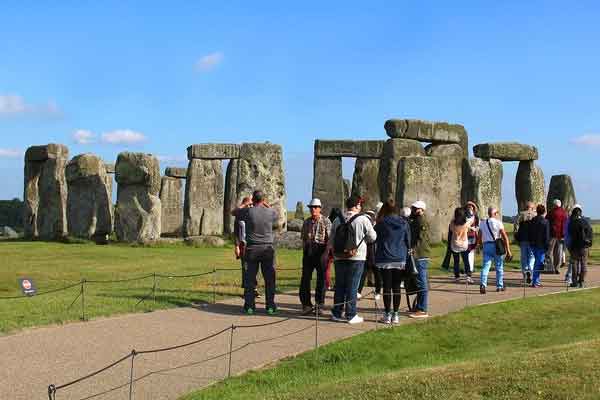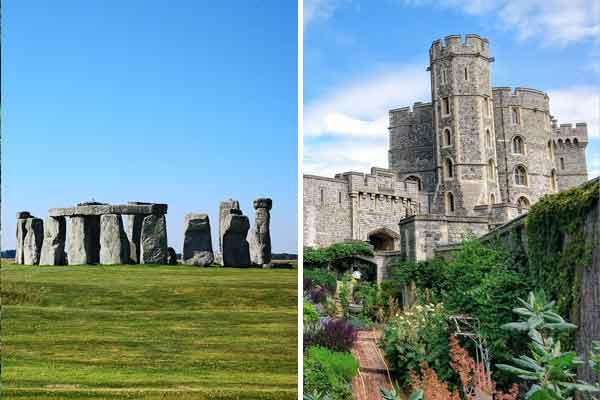Visiting Stonehenge
The Complete Guide for a Memorable Trip
Visiting Stonehenge: An In-Depth Guide
When visiting Stonehenge in Wiltshire, you’re immersing yourself in a segment of prehistory that captivates and intrigues people universally. Recognised as a UNESCO World Heritage Site, this monumental stone circle is not just a treasure for Britain but for the whole world. It’s a place that leaves you pondering about the incredible skills and motives of our ancient ancestors.
The sight of these massive stones, erected thousands of years ago, is genuinely awe-inspiring. As someone who has visited Stonehenge both as a local and as a tourist, I can tell you that its scale and presence are even more impressive in person. The enduring mystery of how and why Stonehenge was built adds to its intrigue. Was it a ceremonial site, a burial ground, or linked to astronomical events? We might never fully understand, but that’s part of its charm.
The alignment of the stones with the solstices is particularly fascinating. If you can, visiting during the summer solstice is a unique experience, watching the sunrise align with the Heel Stone. It’s a busy time, but the atmosphere is electric – a modern connection to an ancient tradition.
Set against the picturesque backdrop of the Wiltshire countryside, Stonehenge’s setting is as striking as the monument itself. The surrounding landscape, dotted with burial mounds and other historical sites, adds layers to the story of Stonehenge. It’s a perfect place for a bit of exploration and reflection.
In short, Stonehenge is a must-visit for anyone interested in Britain’s ancient history and the mysteries of our past. It’s not just a collection of stones; it’s a symbol of human ingenuity and endurance through the ages. So, grab your walking boots and a camera, and prepare to be captivated by this remarkable piece of our heritage.
Practical Information for Visiting Stonehenge
Getting There
Address: Stonehenge, Salisbury, Wiltshire SP4 7DE
By Car: 88 miles / 142km, approx. 1.5-2h drive from Central London
By Train: Nearest station is Salisbury, 9.5 miles from Stonehenge
By Coach: Direct service from Heathrow Airport and Victoria Coach Station to Amesbury
Opening Times
Open every day except Christmas Day between 9:30am – 5pm. Last entry 3pm.
Special access inner circle tours are usually scheduled during early mornings and late evenings outside of standard opening hours.
Time Needed to Visit
Allocate at least 2.5-3 hours but you can easily spend many more hours exploring the exhibition and the landscape.
Accessibility
Stonehenge offers accessibility features to ensure an inclusive experience for all visitors. The site provides designated parking spaces for disabled visitors, with drop-off points available near the visitor centre. Wheelchair users can access the visitor centre, exhibition, and café via ramps and lifts, while accessible toilets are conveniently situated throughout the site. Stonehenge’s shuttle service offers wheelchair-accessible vehicles, transporting visitors from the visitor centre to the monument itself. Additionally, tactile models and audio guides are available to enhance the experience for visually impaired visitors, providing insightful interpretations of this ancient wonder. English Heritage continually strives to improve accessibility, enabling everyone to engage with the mysteries and history of Stonehenge.
Getting to Stonehenge
Each mode of transportation offers unique benefits. Whether it’s the flexibility of driving, the scenic journey by train, the budget-friendly bus route, or the convenience of an organised tour, your choice will depend on your preferences, budget, and the type of experience you are looking for.
- Route: From London, take the M25, M3, and A303.
- Journey Time: Approximately 1.5 to 2 hours.
- Distance: Around 88 miles (142 km).
- Parking: Free for ticket holders near the visitor centre.
- Ideal for flexibility and exploring surrounding areas.
- Nearest Station: Salisbury, 9.5 miles from Stonehenge.
- Journey Time: About 1.5 hours from London Waterloo.
- Additional Travel: Taxi or bus tour from Salisbury.
- Scenic journey; taxis offer convenience, while bus tours, detailed later in the tours section, provide an immersive experience.
- Direct Services: From Heathrow Airport and Victoria Coach Station to Amesbury.
- Journey Time: Around 2 hours or more.
- Additional Travel: Short distance from Amesbury to Stonehenge.
- Direct and economical; suitable for travellers without a car.
Through Organised Tours
- Options: Various tours available, including combined tours with Bath and Windsor.
- Convenient for those seeking a comprehensive experience with guided insights. More details on specific tours are provided in the tours section of this guide.
Arrival at Stonehenge Visitor Centre
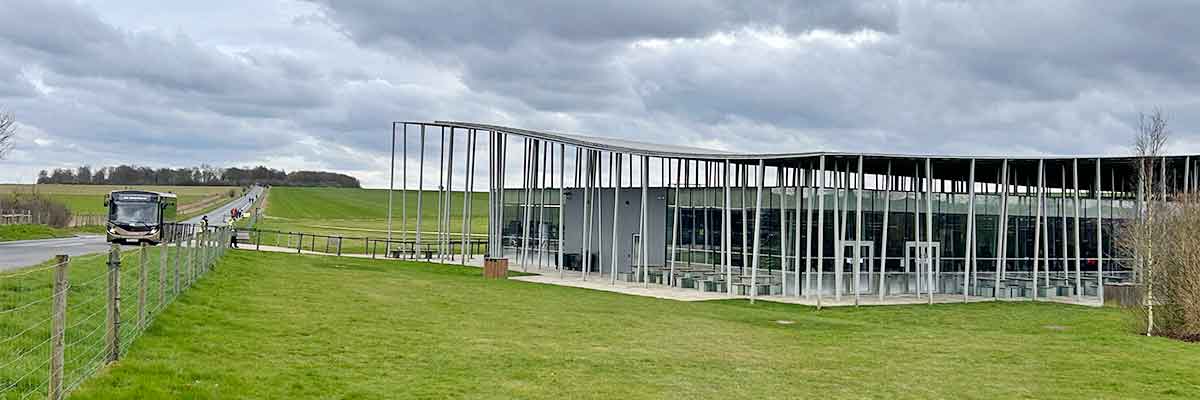
Regardless of how you arrive at Stonehenge – be it by tour, car, train, or bus – all visitors first congregate at the Stonehenge Visitor Centre. This is your starting point for exploring Stonehenge.
- Location: The Visitor Centre is situated approximately 1.5 miles from the Stone Circle.
- Shuttle Service: To reach the stones, you have the option to take a free shuttle bus. This service is convenient and quick, with the journey to the stones taking about 10 minutes.
- Walking Option: Alternatively, you can choose to walk from the Visitor Centre to the stones. The walk is scenic and immersive, offering a chance to experience the ancient landscape at a leisurely pace.
The Visitor Centre itself is a treasure trove of information, providing insights into the history and significance of Stonehenge. Whether you opt for the shuttle or decide to walk, this part of your visit plays a crucial role in setting the stage for your experience at the stone circle.
What Facilities and Features Does the Stonehenge Visitor Centre Offer?
The Stonehenge Visitor Centre provides an enriching start to your visit. It features a range of exhibitions, including hundreds of prehistoric objects and tools that offer insights into the lives of the people who built and used Stonehenge.
The centre also includes a spacious café and a well-stocked shop. Additionally, there are facilities to enhance your visit, such as audio guides and interactive displays, making it a valuable resource for both first-time visitors and those looking to deepen their understanding of this historic site.
Opening Times
Stonehenge is open every day except Christmas Day, 25 December.
- Opening Time: 9:30am
- Closing Time: 5pm
- Last Admission: 3pm
Duration: Once entered at the specific time booked for, visitors can stay as long as they like until closing time.
Stonehenge Tickets and Prices
General Admission Tickets
- Online Booking: Purchasing tickets online in advance is recommended. Prices vary based on peak and off-peak times.
- Ticket Prices: Adult General Admission tickets bought online range from £20 to £31, depending on the day. On-site purchase at the Visitor Centre costs more.
- Discounts: Available for students, children, and families.
- Timed Entry: Each ticket is for a specific time slot, and visitors must arrive within 30 minutes of their booked time.
- Stay Duration: Once entered, visitors can stay as long as they like until closing time.
Off-Peak Prices
Typically Mon-Fri all year except Jun-Aug and some Fridays
Standard Prices
Typically Sat-Sun for Sep-Mar and Mon-Fri for Jun-Aug
Peak Prices
Typically Sat-Sun for Jun-Aug and some weekends Sep-Mar
Special Access - Inner Circle Tours
- Exclusive Access: For up-close access to the stones, special Inner Circle Tours are available.
- Availability: Special Access tickets and tours sell out fast, booking in advance is advised.
- Booking: These tours can be booked through English Heritage or private tour operators, often including transportation from London.
- Timing: Tours are typically early morning or late evening, outside standard operating hours.
- Cost: Costs vary, with English Heritage offering a direct booking option, and private tours generally being more expensive.
Membership and Passes
- English Heritage and National Trust Members: Free entry for members, but pre-booking a time slot is still required.
- Overseas Visitors: An English Heritage Attractions Pass is available for international visitors, offering free entry to over 100 sites, including Stonehenge.
Visitor Centre and Shuttle Service
- Location: The Stonehenge Visitor Centre is about 1.5 miles from the stone circle.
- Facilities: It includes exhibitions, a café, gift shop, and an outdoor area with reconstructed Neolithic houses.
- Shuttle Service: Free shuttle buses run from the Visitor Centre to the stones, taking approximately 10 minutes.
- Walking Option: For those preferring to walk, there is a pedestrian path from the Visitor Centre to the stone circle.
- Walking Time: The walk is approximately 1.5 miles and takes around 30-40 minutes, depending on your pace. This walk provides a more immersive experience, allowing visitors to appreciate the landscape and approach Stonehenge gradually, enhancing the sense of discovery. Choosing to walk can be a rewarding experience, giving you a sense of the scale of the landscape and a deeper connection to the setting of Stonehenge. However, it’s essential to be prepared for the weather and wear comfortable walking shoes.
Stonehenge Tours
Stonehenge Tours from London
Embark on a journey through England’s heritage and landscapes with a full-day combined tour from London, or opt for a half-day Stonehenge tour for a focused exploration.
Half-Day Tours
Half-day tours run in the mornings or afternoons and offer an immersive experience at the enigmatic Stonehenge site, allowing ample time to uncover its mysteries and significance.
See all half-day tours to Stonehenge »
Full-Day Combination Tours
Full-day combined tours seamlessly blend visits to iconic destinations such as Bath, Windsor Castle, Oxford, Cotswold villages, Salisbury and more, each offering its own unique charm and history. From the ancient Roman Baths to the regal splendour of Windsor Castle, and the timeless beauty of the Cotswolds, these tours promise an unforgettable exploration guided by knowledgeable experts. Whether opting for a half-day or full-day excursion, you’re sure to discover the best of England’s cultural treasures and natural wonders.
See all full-day combination tours visiting Stonehenge »
Why combined tours?
- Tailored for both individuals and groups, these tours offer a comprehensive experience with knowledgeable guides.
- They provide convenient transportation, often with amenities like Wi-Fi and USB charging.
- Combined tours can offer a more in-depth exploration of each site, including historical context and insights not readily available to independent travellers.
- They can be cost-effective and time-efficient, especially for those with limited time to explore.
Special Access - Inner Circle Tours
In addition to standard tours, there are specialist inner circle tours to Stonehenge, offering exclusive access to the ancient monument during magical moments like sunrise or sunset where the ancient stones are bathed in the warm hues of the rising or setting sun.
These tours, often scheduled in the early morning or late afternoon/evening, provide a rare opportunity to get up close to the stones, an experience not available on regular tours. Stonehenge special access tours are popular and sell out fast, so it’s crucial to book early not to miss out.
Stonehenge Tours from Salisbury
These tours offer a hop-on-hop-off experience, allowing visitors to explore not only Stonehenge but also other significant historical sites in the area. The tour typically includes stops at Old Sarum, a site with Iron Age, Roman, and medieval history, and the beautiful Wiltshire countryside. This format provides flexibility and the opportunity to delve into each location at your own pace.
A Selection of Popular Stonehenge Tours
Here is a selection of three most popular Stonehenge tours. Please visit our dedicated Stonehenge Tours page for the full list of tours we selected.
Coach Tour
Audio Guide
Stonehenge
- Stonehenge admission
- Luxury air-conditioned coach transfer
- This tour is unescorted
- Audio guides at Stonehenge
- This tour is not accessible
- Starts & ends in Central London
- Arrive at 8am, departs at 8:30am
- Duration: 6 hours approx.
- Adult (17+) from £64
- Child (5-17 years) from £61
Our Verdict: This is a great affordable alternative to fully guided tours while spending more time at Stonehenge than other combination tours that visit more than two locations. Also perfect for those with limited time as it’s a half day morning tour.
Coach Tour
Tour Guide
Stonehenge
Stroller Accessible
- Guided Group Coach Tour (53 max)
- Luxury coach with Wi-Fi & USB charging
- English speaking expert tour guide
- Admission to Stonehenge
- Optional admission to Windsor Castle
- This tour is stroller accessible but not wheelchair accessible
- Starts & ends in Central London
- Arrive at 8am, departs at 8:30am
- Duration: 9 hours approx.
- Adult (17-59) from £100
- Senior (60+) from £95
- Child (3-16) from £90
- Infant (0-2) free
Our Verdict: Highly recommended for a deep dive into southern England’s history, this full-day coach trip from London visits the enigmatic Stonehenge and the elegant city of Bath.
Marvel at the ancient stones of Stonehenge with included audio guides, and explore Bath’s Georgian architecture at your leisure.
Optional upgrades include the Roman Baths and the Jane Austen Centre. This tour uniquely offers extended time in Bath, providing a thorough and enriching experience.
Visiting Stonehenge: What to Expect
Visiting Stonehenge is an experience filled with awe and historical wonder. Here’s what you can expect during your visit:
Arrival and First Impressions
- Visitor Centre: Your journey starts at the Stonehenge Visitor Centre, where you can explore exhibitions, view ancient artifacts, and gather information about the site.
- Travel to the Stones: From the Visitor Centre, you can take the free shuttle bus or walk to the stone circle, a journey that immerses you in the landscape’s history.
The Stone Circle
- Viewing the Stones: You will have the opportunity to walk around the iconic stone circle. While direct access to the stones is restricted to protect the site, the pathway offers excellent views for photography and contemplation.
- Audio Guides: Available for a small fee or via a free app, audio guides provide valuable insights into the history and theories surrounding Stonehenge.
The Surrounding Landscape
- Ancient Grounds: The area around Stonehenge is rich in history, dotted with burial mounds and other archaeological sites.
- Neolithic Houses: Outside the Visitor Centre, you can explore reconstructed Neolithic houses, offering a glimpse into how people lived 4,500 years ago.
Experience Through the Seasons
- Changing Landscape: The landscape of Stonehenge changes with the seasons, from the lush greenery of spring and summer to the stark beauty of winter.
- Special Events: The summer and winter solstices are particularly special times to visit, though they can be more crowded.
Practical Aspects
- Facilities: The Visitor Centre includes a café and a gift shop, perfect for refreshments and souvenirs.
- Accessibility: The site is equipped to cater to visitors with disabilities, ensuring a comfortable experience for everyone.
Visiting Stonehenge is a journey back in time, offering a unique blend of historical intrigue and natural beauty. Whether you’re a history enthusiast or simply looking for a remarkable experience, Stonehenge promises a memorable visit.
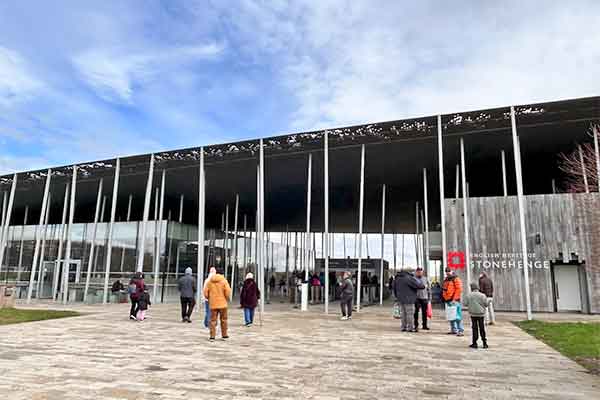
Visitor Centre
Your journey starts at the Stonehenge Visitor Centre, where you can explore exhibitions, view ancient artifacts, and gather information about the site.

Visitor Centre
Your journey starts at the Stonehenge Visitor Centre, where you can explore exhibitions, view ancient artifacts, and gather information about the site.

Visitor Centre
Your journey starts at the Stonehenge Visitor Centre, where you can explore exhibitions, view ancient artifacts, and gather information about the site.
Visitor Facilities
Visiting Stonehenge is made comfortable and convenient thanks to a range of visitor facilities designed to enhance your experience. These facilities ensure that all visitors, regardless of age or mobility, can enjoy their visit to Stonehenge comfortably and conveniently.
The heart of the visitor facilities, it includes extensive exhibitions about Stonehenge’s history and significance, membership office, a gift shop for souvenirs, and a café serving a variety of food and drinks.
Visitors to Stonehenge can enjoy the convenience of ample restroom and baby changing facilities, catering to the diverse needs of all guests, including those with disabilities.
The site is equipped to accommodate visitors with disabilities. This includes accessible paths to the stone circle and wheelchairs available on a first-come, first-served basis.
Near the Visitor Centre at Stonehenge, visitors will find abundant parking facilities conveniently located, ensuring ease of access for all guests, free for ticket holders.
For those who prefer to bring their food, there are designated picnic areas where you can enjoy a meal in the picturesque surroundings.
What is the Neolithic Era?
The Neolithic Era, often referred to as the New Stone Age, marks a profound period in human history. This era, which dates from about 12,000 to 6,500 years ago, saw significant developments in human society, particularly in terms of agriculture, tool-making, and settling patterns.
- Transition from Nomadic to Settled Life: One of the most significant changes during the Neolithic Era was the shift from nomadic lifestyles, where people were hunters and gatherers, to a more settled way of life based on agriculture. This allowed for the development of permanent settlements.
- Advancements in Tool-Making: The era is characterised by the creation of more sophisticated stone tools, pottery, and the development of weaving techniques.
- Domestication of Animals and Agriculture: The domestication of animals and cultivation of crops such as wheat and barley led to more stable food sources.
- Development of Complex Societies: These changes paved the way for the development of complex societies, trade networks, and the beginnings of modern civilisation.
In the context of Stonehenge, the Neolithic Era is particularly relevant as this monument was constructed during the late Neolithic period. The structures and artifacts found at Stonehenge provide valuable insights into the lives, beliefs, and practices of the people living during this transformative time in human history.
Exploring the Stonehenge Landscape
The landscape surrounding Stonehenge is as rich in history and intrigue as the monument itself, offering visitors a chance to explore the broader context of this ancient site.
- Ancient Burial Mounds: The area around Stonehenge is dotted with numerous burial mounds, providing insights into the burial practices of the ancient peoples.
- Woodhenge: Located near Stonehenge, Woodhenge is another ceremonial monument, believed to be contemporary with Stonehenge, offering a different perspective on Neolithic ceremonial practices.
- Durrington Walls: This is the site of a large Neolithic settlement and ceremonial complex, believed to be closely linked with Stonehenge.
- Avebury: A short drive away, Avebury is another Neolithic henge monument, larger and older than Stonehenge, and surrounded by a charming village.
- Walking Trails: The landscape is crisscrossed with public footpaths, offering scenic walks through the rich historical landscape.

Solstice at Stonehenge
Stonehenge has long been associated with the solstices, both summer and winter, due to its unique alignment with the sun’s movements. These solstices are key astronomical moments that have been celebrated and revered across various cultures and time periods.
Summer Solstice at Stonehenge
The summer solstice, around June 21st, is the longest day of the year. At Stonehenge, this day is marked by the sunrise aligning perfectly with the Heel Stone, located outside the main stone circle. This alignment allows the rays of the sunrise to shine directly into the heart of Stonehenge.
The monument was carefully designed to frame this particular event, suggesting its importance to the people who built it. The summer solstice at Stonehenge is a time of celebration and has historically been associated with new beginnings and the life-giving power of the sun.
Winter Solstice at Stonehenge
Conversely, the winter solstice, which occurs around December 21st or 22nd, is the shortest day of the year. During this time, the sun sets between two large stones in the stone circle, known as the Trilithon, and aligns with the Altar Stone. This event may have held special significance as it marked the reversal of the sun’s ebbing presence in the sky, symbolising rebirth and renewal.
The winter solstice might have been a time for rituals relating to the deceased, as evidenced by the many burial mounds in the vicinity of Stonehenge.
Cultural and Ritual Significance
The precise alignments of Stonehenge with the solstices highlight its potential role as an ancient astronomical calendar, but it also suggests a deeper cultural and ritual significance. The builders of Stonehenge, who were primarily farmers, would have deeply valued these astronomical events, which marked crucial turning points in the agricultural year.
The solstices likely played a role in their religious and ceremonial life, possibly involving feasting, rituals, and remembrance of ancestors.
Modern Celebrations
In modern times, Stonehenge has become a focal point for solstice celebrations, drawing crowds who wish to experience this ancient astronomical event first-hand.
These gatherings are a blend of ancient and contemporary traditions, often including people with spiritual or religious beliefs related to the monument and its past. English Heritage, which manages the site, provides managed open access during the solstices, allowing people to experience these moments in a controlled environment that respects the site’s heritage and significance.
The solstices at Stonehenge continue to be a powerful symbol of the connection between our ancient ancestors and the natural world, demonstrating the enduring legacy of this prehistoric monument.
For more detailed insights into the solstice celebrations at Stonehenge, you can visit the English Heritage website and the British Museum website.
Modern Day Mages and Witches and Their Relation to Stonehenge
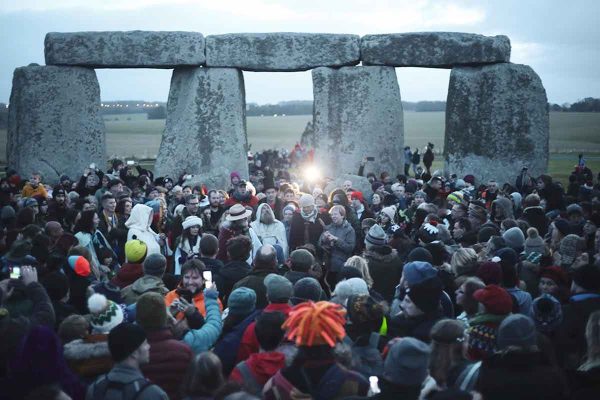
Stonehenge has long been a site of spiritual significance, not only for its historical and archaeological importance but also for its connections to various modern-day pagan and neo-druidic practices.
- Neo-Druidism and Paganism: Modern-day mages, witches, and practitioners of neo-druidism often see Stonehenge as a sacred place. They view it as a connection to the Earth, nature, and ancestral wisdom.
- Solstice Celebrations: Many pagans and neo-druids gather at Stonehenge during the summer and winter solstices. These events are seen as times of power, renewal, and celebration within their spiritual calendar.
- Rituals and Ceremonies: The practices and rituals carried out by these groups at Stonehenge can vary widely, but they often include ceremonies that honor the cycles of nature, the elements, and ancestral spirits.
- Resurgence of Interest: The 20th century saw a resurgence in interest in ancient Druidic practices and beliefs, leading to an increased presence of modern-day mages and witches at Stonehenge.
- Respect for Heritage: While these modern practices are inspired by ancient beliefs and rituals, it is important to note that they are not direct continuations of the prehistoric activities that took place at Stonehenge. Modern groups often work to respect the heritage and archaeological significance of the site.
These modern interpretations and practices highlight Stonehenge’s enduring appeal and the way it continues to inspire spiritual and mystical experiences.
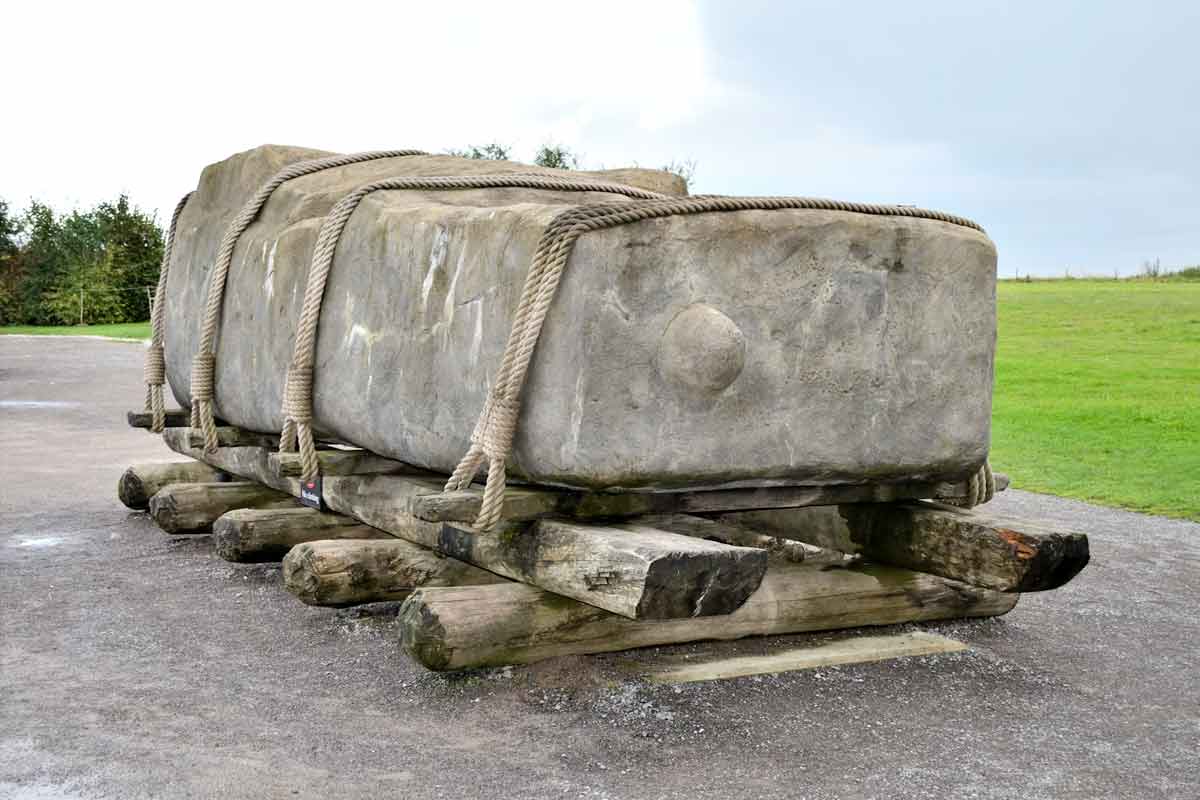
History: Who Built Stonehenge?
The builders of Stonehenge remain one of the great mysteries of history. The construction of Stonehenge is believed to have been carried out in several phases spanning over 1500 years, starting from around 3000 BC.
- Early Neolithic Builders: The earliest phase of construction is attributed to Neolithic peoples. These were likely farming communities who had settled in the area, shifting from a nomadic hunter-gatherer lifestyle to a more settled agricultural one.
- Later Contributions: Subsequent phases of construction, particularly the setting up of the large sarsen stones, are thought to have occurred around 2500 BC. This period likely involved different groups or generations, indicating a long-term project that spanned different societal changes.
- Cultural and Social Significance: The construction and use of Stonehenge suggest it was an important cultural and ritual site for these prehistoric communities. Its alignment with the solstices indicates a sophisticated understanding of astronomy.
Despite extensive archaeological studies, the exact identity of the Stonehenge builders remains unknown. Theories suggest that it could have been the work of a series of different communities over time, each contributing to the site’s development in their distinct ways. The builders’ identity is likely to remain part of the Stonehenge enigma, adding to the site’s intrigue and allure.
Is it true that farmers from Turkey built Stonehenge?
Recent genetic research has shed light on the origins of the people who built Stonehenge, suggesting that they were likely descended from farmers who migrated from the eastern Mediterranean, specifically an area near modern-day Turkey. This migration is believed to have occurred around 4000 BC, a time when these Neolithic farmers replaced the local hunter-gatherer populations in Britain.
The analysis of DNA from ancient skeletons, including both Neolithic farmers and earlier Mesolithic hunter-gatherers, has revealed that the majority of the hunter-gatherer population in Britain was replaced by those carrying ancestry from the Aegean coast of modern Turkey. These findings indicate that the development of farming and Neolithic cultures in Britain was largely driven by this wave of migration from mainland Europe.
The transition to farming, brought by these immigrant farmers, represents a significant technological innovation in human evolution. It marked the end of the hunter-gatherer lifestyle that had prevailed until then and led to the establishment of more settled and structured communities. This transition is crucial to understanding the construction of Stonehenge, which began around 3000 BC, suggesting that the monument was likely built by the descendants of these eastern Mediterranean farmers.
This research provides a new perspective on the ancient Britons who built Stonehenge, indicating a cultural and genetic link to ancient Aegean populations rather than to the native Britons of the time. However, the exact methods used to transport and erect the massive stones at Stonehenge continue to be a subject of intrigue and speculation.
These insights come from studies and reports by scientists at institutions like London’s Natural History Museum and University College London, as reported by The Independent and Mental Floss. Study itself can be found here.
Stonehenge Facts and Trivia
Stonehenge is a treasure trove of fascinating facts and figures:
- Age: Archaeologists estimate that the construction of Stonehenge began around 3000 BC and continued in phases until about 1600 BC.
- Construction: The monument consists of a ring of standing stones, with each standing stone around 13 feet high, 7 feet wide, and weighing approximately 25 tons.
- Bluestones: The smaller stones, known as bluestones, weigh up to 4 tons each and are believed to have been transported from the Preseli Hills in Wales, nearly 200 miles away.
- Alignment: Stonehenge is aligned with the sunset of the winter solstice and the sunrise of the summer solstice, indicating its possible use as an ancient astronomical calendar.
- Burials: Archaeological evidence suggests that the area around Stonehenge was used for burials for centuries, with hundreds of burial mounds nearby.
- Visitors: Stonehenge attracts more than 1.5 million visitors annually, making it one of Britain’s most popular tourist attractions.
Stonehenge Legends and Myths
Stonehenge has been a source of myth and legend throughout history:
- Merlin’s Involvement: One of the most famous legends involves Merlin, the wizard of Arthurian legend, who is said to have magically transported the stones from Ireland.
- Healing Stones: During the Middle Ages, Stonehenge was believed to have healing properties, and its stones were thought to be able to cure illnesses.
- Druids: Although it is a popular belief that Stonehenge was built by Druids, this is a misconception; the Druids came into existence long after Stonehenge was constructed.
- Alien Theories: Some theories suggest that Stonehenge’s construction was influenced by extraterrestrial beings due to the precision and effort required to build such a structure in that era.
- Sacred Site: Many people today consider Stonehenge a sacred site and believe it holds special spiritual or magical power.
These legends and myths, while often not supported by archaeological evidence, contribute to the mystery and allure of Stonehenge, making it a subject of fascination and speculation.
Read more about Stonehenge Mysteries here.
Practical Tips for Your Stonehenge Visit
Visiting Stonehenge can be a magical experience if you’re well-prepared. Here are some practical tips:
- Best Times to Visit: The site is generally less crowded during weekdays and outside of peak tourist seasons (summer and school holidays). Early mornings or late afternoons may offer a more peaceful experience.
- Weather Considerations: The British weather can be unpredictable. Check the forecast and dress accordingly. Layered clothing is advisable as it can be windy on the plains.
- What to Bring: Comfortable walking shoes are a must. Consider a hat and sunscreen for sunny days, and waterproof clothing for rainy weather. Don’t forget your camera, but remember that tripods may be restricted.
- Facilities: Make use of the facilities at the Visitor Centre before heading to the stones, as there are no facilities at the stone circle itself.
- Accessibility: Stonehenge is accessible to visitors with disabilities, but it’s advisable to check the latest information on available facilities before your visit.
Nearby Attractions and Practical Information for Visiting

Salisbury
- Location: About 10 miles south of Stonehenge.
- Highlights: Salisbury Cathedral with the tallest spire in the UK and an original Magna Carta.
- Getting There: Salisbury is about a 30-minute drive from Stonehenge. Public buses and trains from various parts of the UK, including direct routes from London, also serve Salisbury.
- Tips: The city offers charming streets, eateries, and the Salisbury Museum, which is worth a visit for its local history exhibits.

Amesbury
- Location: Approximately 2 miles from Stonehenge.
- Highlights: Known for its ancient history and close proximity to Stonehenge.
- Getting There: Amesbury is just a few miles from Stonehenge and can be easily reached by car or local bus services.
- Tips: Explore the town centre for quaint shops and cafes, and don’t miss the Amesbury Archer exhibit at the Salisbury Museum.
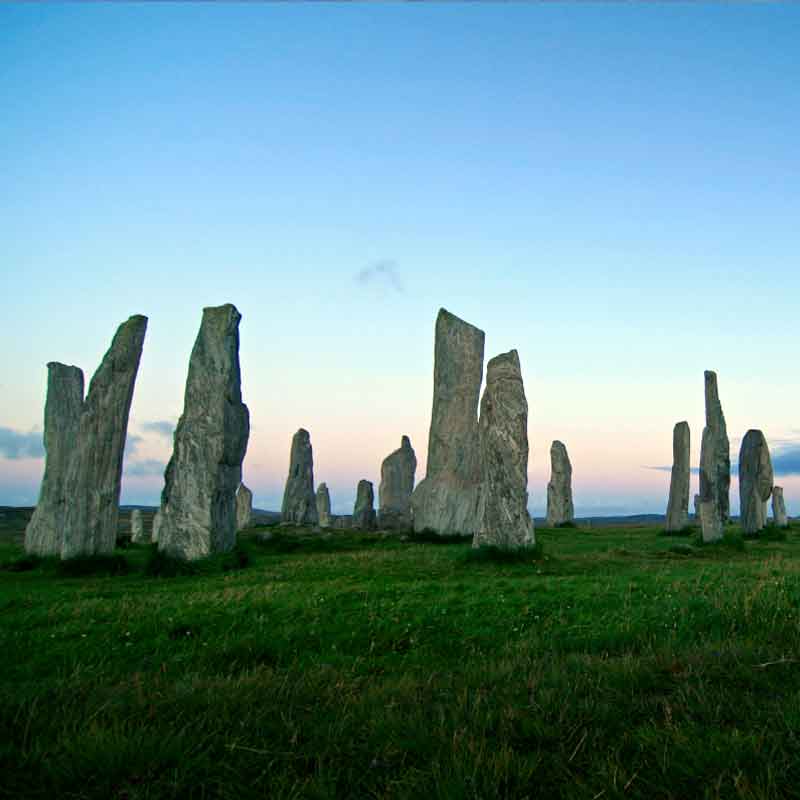
Avebury
- Location: Roughly 17 miles north of Stonehenge.
- Highlights: A larger henge monument with an accessible stone circle.
- Getting There: Avebury is around a 30-minute drive from Stonehenge. Public transportation options include buses from nearby towns, although a car journey might be more convenient for direct access.
- Tips: Avebury is part of a larger Neolithic landscape, including Silbury Hill and West Kennet Long Barrow, which are also worth exploring.
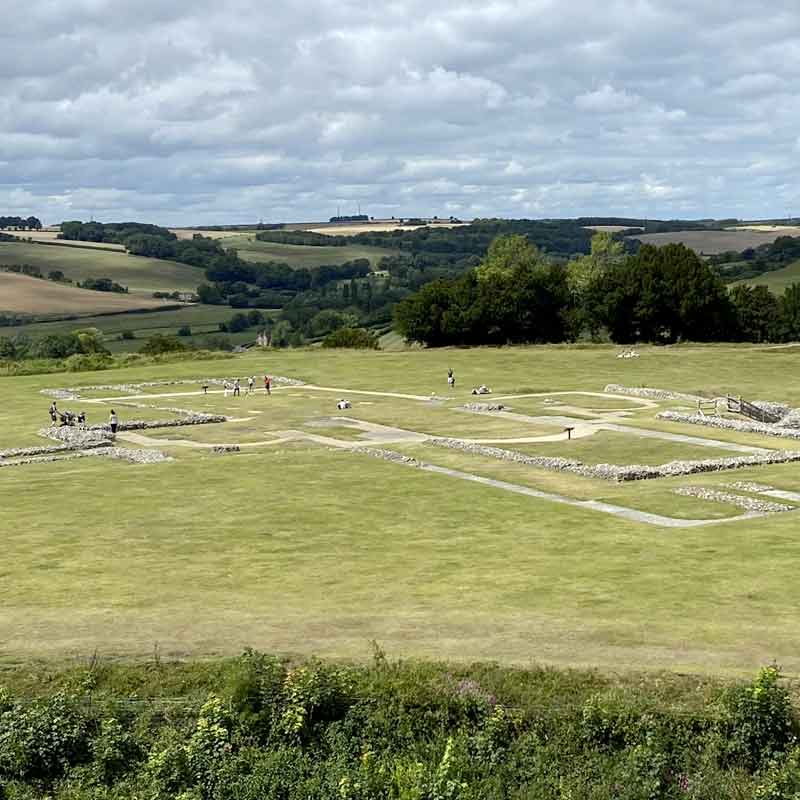
Old Sarum
- Location: Just north of Salisbury.
- Highlights: The ruins of the earliest settlement of Salisbury, including a castle and cathedral.
- Getting There: Old Sarum is situated just north of Salisbury, about a 20-minute drive from Stonehenge. Public buses also run from Salisbury city centre.
- Tips: Offers fantastic views over Salisbury and the surrounding countryside. Ideal for picnics and exploring the ruins.
Preservation and Conservation of Stonehenge
Stonehenge’s preservation and conservation are vital aspects of its management, ensuring this historical site remains intact for future generations:
- Visitor Management: To prevent wear and tear on the ancient structure, visitor access to the stone circle itself is generally restricted. This helps in preserving the integrity of the stones and the site.
- Environmental Protection: Efforts are made to protect the surrounding landscape, which is key to understanding Stonehenge’s context and history.
Archaeological Research: Ongoing research helps in understanding how Stonehenge was built and used, informing better conservation strategies. - Collaborations: English Heritage works with other organisations and experts in conservation to maintain the site’s condition.
- Educational Programs: These programs aim to educate visitors about the importance of preserving such a significant historical site.
Through these efforts, Stonehenge continues to be a well-preserved window into the distant past, enabling people to connect with a time long gone.
Stonehenge in Popular Culture
Stonehenge has had a significant presence in popular culture, often symbolizing mystery and ancient power:
- Literature: It has been the subject of numerous books and poems, often depicted as a place of mystery and ancient rituals.
- Movies and TV Shows: Stonehenge has featured in films and television shows, ranging from historical dramas to science fiction, such as in “Doctor Who” and “Outlander”.
- Music: The monument has inspired various musical compositions and songs, with references in the works of artists like Spinal Tap and Led Zeppelin.
- Conspiracy Theories and Pseudoscience: It often appears in various theories related to aliens, ancient astronauts, and other unexplained phenomena.
- Art and Photography: Stonehenge’s striking appearance makes it a popular subject for artists and photographers, appearing in countless artworks and photographs.
As a cultural icon, Stonehenge continues to inspire, intrigue, and mystify, maintaining its status as a symbol of ancient knowledge and power.
Frequently Asked Questions (FAQ) About Visiting Stonehenge
Can I touch the stones at Stonehenge?
No, visitors are not allowed to touch the stones during regular visits to protect and preserve the site. However, during special access tours or solstice celebrations, you may get closer to the stones.
Is Stonehenge accessible to visitors with disabilities?
Yes, Stonehenge is accessible to visitors with disabilities. The visitor centre, exhibition spaces, and shuttle buses are designed to accommodate wheelchair users.
How long does it take to visit Stonehenge?
Typically, a visit to Stonehenge can take about 1-2 hours, including time spent at the visitor centre and walking around the stone circle.
Can I visit Stonehenge without a ticket?
No, you need a ticket to enter Stonehenge. Tickets must be purchased in advance, especially during peak seasons and solstice events.
Are there any facilities at Stonehenge?
Yes, the Stonehenge Visitor Centre has facilities including a café, a gift shop, toilets, and an exhibition space with artifacts and information about the site.
What is the best time of year to visit Stonehenge?
While Stonehenge can be visited year-round, the best time to visit depends on your interests. Summer and winter solstices are popular for special events, but they are also the busiest times.
Is photography allowed at Stonehenge?
Yes, photography is allowed for personal use. However, the use of drones or commercial photography requires permission.
Can I bring my pet to Stonehenge?
Pets are not allowed within the Stonehenge monument area, except for assistance dogs.
Are there guided tours available?
Yes, there are guided tours available, both from London and at the site. These tours often provide additional historical context and insights.
What should I wear when visiting Stonehenge?
Considering the open landscape and the British weather, it’s advisable to wear weather-appropriate clothing and comfortable walking shoes.
Can I visit nearby attractions on the same day as Stonehenge?
Yes, nearby attractions like Salisbury, Amesbury, and Avebury can be visited on the same day, but it’s best to plan your itinerary to allocate sufficient time for each.
How can I get to Stonehenge using public transport?
Stonehenge is accessible by train and bus. The nearest train station is Salisbury, from where you can take a bus or taxi to Stonehenge.
harper
Personal Reflections on Visiting Stonehenge
My experiences at Stonehenge, both as a local Londoner and as an international tourist, have been deeply fascinating.
One of the most captivating aspects is witnessing the modern-day druids and pagans in ancient robes during solstice celebrations. Seeing them participate in ancient rituals amidst the mystical stones bridges a connection between the distant past and the present, making the experience surreal and unique.
These gatherings, particularly during the summer and winter solstices, offer a colourful and vibrant spectacle that adds to the mystique of Stonehenge. The blend of ancient traditions with contemporary practices against the backdrop of these prehistoric stones is a powerful reminder of the site’s enduring significance through the ages.

